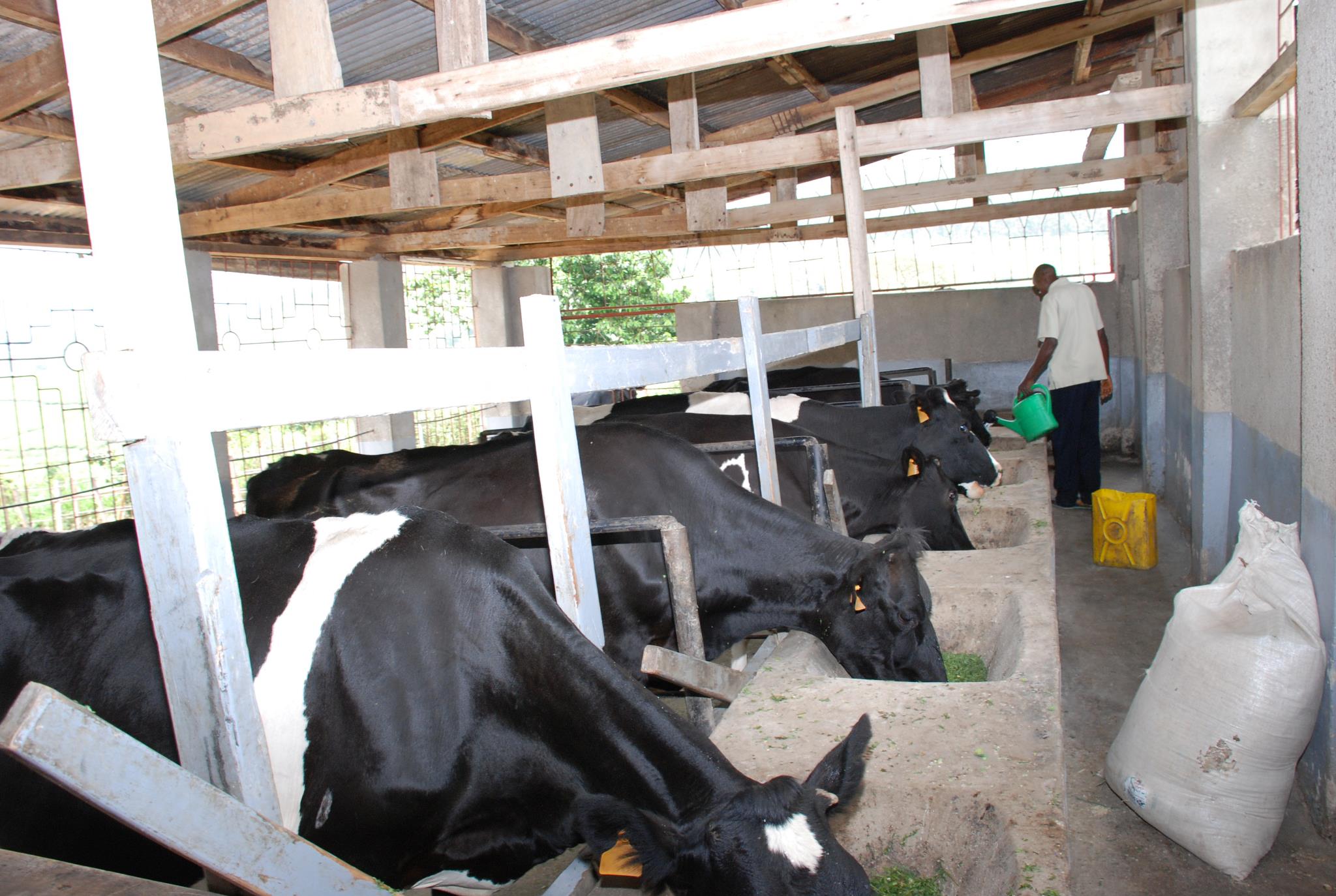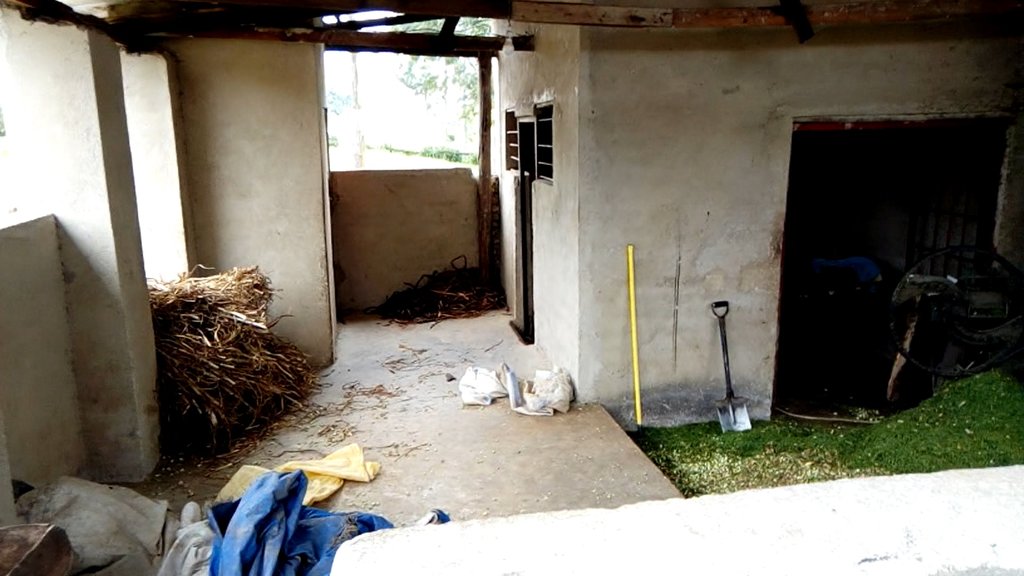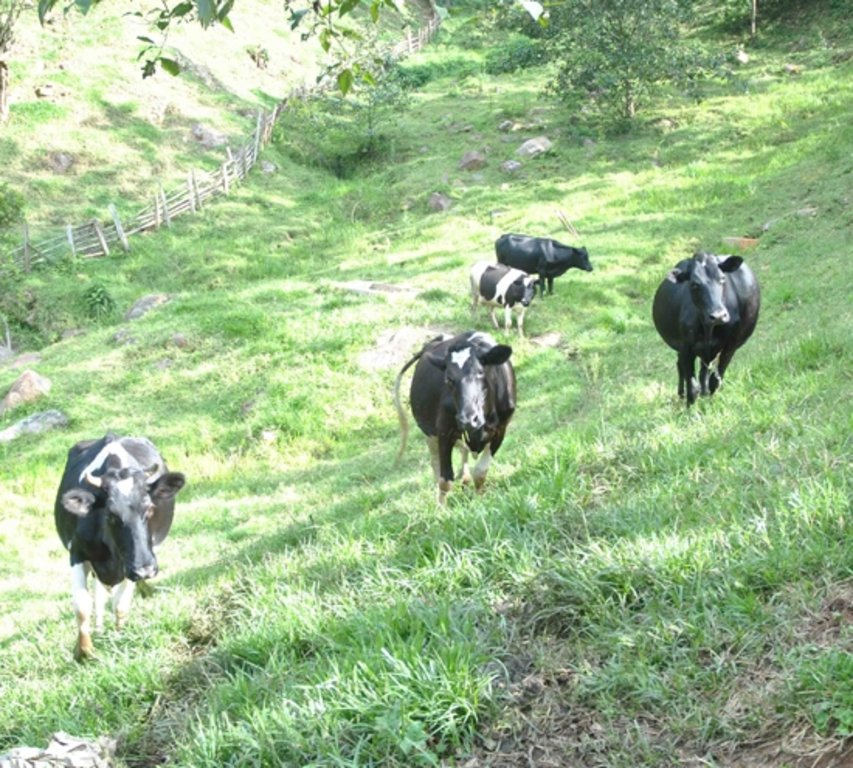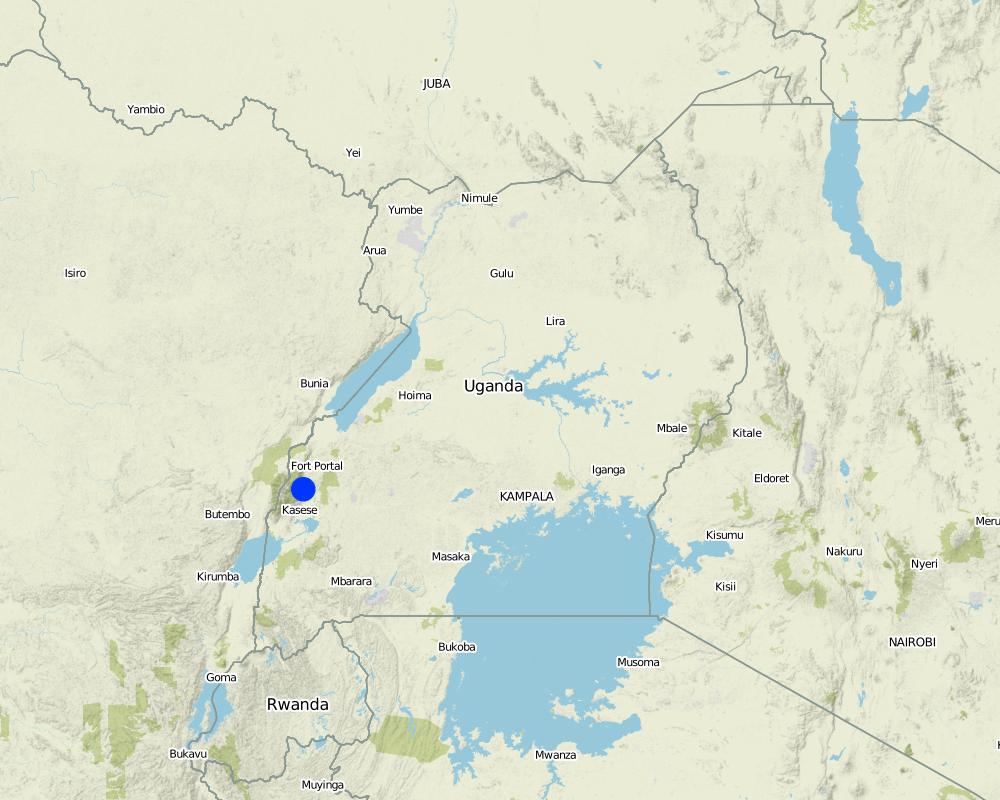Cattle Fodder processing [ยูกันดา]
- ผู้สร้างสรรค์:
- การอัพเดท:
- ผู้รวบรวม: Aine Amon
- ผู้เรียบเรียง: –
- ผู้ตรวจสอบ: Rima Mekdaschi Studer, Hanspeter Liniger, Donia Mühlematter
Ebinyasi bye ente
technologies_3367 - ยูกันดา
- บทสรุปทั้งหมดในรูปแบบของ PDF
- บทสรุปทั้งหมดในรูปแบบของ PDF เพื่อพิมพ์
- บทสรุปทั้งหมดในรูปหน้าเว็บ
- บทสรุปทั้งหมด (ไม่มีการจัดเรียง)
- Dairy cattle fed with supplementary fodder: 10 สิงหาคม 2018 (inactive)
- Dairy cattle fed with supplementary fodder: 22 สิงหาคม 2019 (public)
- Dairy cattle fed with supplementary fodder : 20 มิถุนายน 2018 (inactive)
- Dairy cattle fed with supplementary fodder : 20 มิถุนายน 2018 (inactive)
- Cattle Fodder processing: 15 มิถุนายน 2018 (inactive)
- Cattle Fodder processing: 21 พฤษภาคม 2018 (inactive)
ดูส่วนย่อย
ขยายทั้งหมด ย่อทั้งหมด1. ข้อมูลทั่วไป
1.2 รายละเอียดที่ติดต่อได้ของผู้รวบรวมและองค์กรที่เกี่ยวข้องในการประเมินและการจัดเตรียมทำเอกสารของเทคโนโลยี
วิทยากรหลัก
ผู้ใช้ที่ดิน:
ชื่อของโครงการซึ่งอำนวยความสะดวกในการทำเอกสารหรือการประเมินเทคโนโลยี (ถ้าเกี่ยวข้อง)
Scaling-up SLM practices by smallholder farmers (IFAD)ชื่อขององค์กรซึ่งอำนวยความสะดวกในการทำเอกสารหรือการประเมินเทคโนโลยี (ถ้าเกี่ยวข้อง)
National Agricultural Research Organisation (NARO) - ยูกันดา1.3 เงื่อนไขการใช้ข้อมูลที่ได้บันทึกผ่านทาง WOCAT
วันที่เก็บรวบรวมข้อมูล(ภาคสนาม) :
19/01/2018
ผู้รวบรวมและวิทยากรหลักยอมรับเงื่อนไขเกี่ยวกับการใช้ข้อมูลที่ถูกบันทึกผ่านทาง WOCAT:
ใช่
1.4 การเปิดเผยเรื่องความยั่งยืนของเทคโนโลยีที่ได้อธิบายไว้
เทคโนโลยีที่ได้อธิบายไว้นี้เป็นปัญหาของความเสื่อมโทรมโทรมของที่ดินหรือไม่ จึงไม่ได้รับการยอมรับว่าเป็นเทคโนโลยีเพื่อการจัดการที่ดินอย่างยั่งยืน:
ไม่ใช่
1.5 อ้างอิงไปที่แบบสอบถามเรื่องแนวทาง SLM
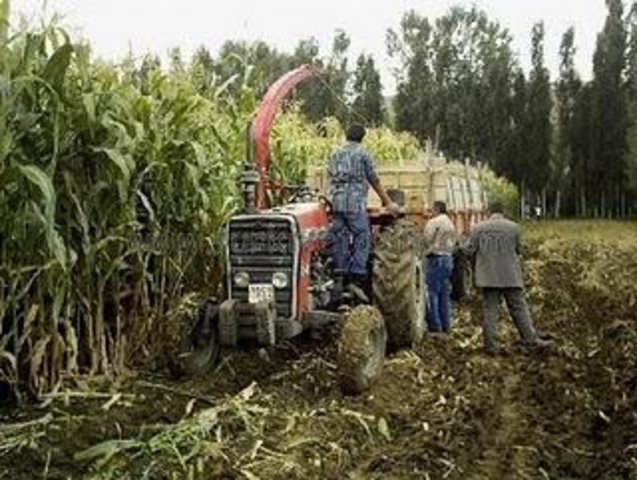
Fodder Crops Production [ตุรกี]
To grow different fodder crop species (leguminous and graminous) for feeding livestock
- ผู้รวบรวม: Unknown User
2. การอธิบายลักษณะของเทคโนโลยี SLM
2.1 การอธิบายแบบสั้น ๆ ของเทคโนโลยี
คำจำกัดความของเทคโนโลยี:
Elephant grass (Pennisteum purpureum) and calliandra (Calliandra haematocephala) are harvested and chopped using a chaff cutter to form chaff fodder. The chaff is then mixed with, cotton seed cake, molasses and maize bran to improve palatability and nutrient quality for dairy cattle. The cattle is left free to graze in the paddocks during the day and are supplemented with the chaffed fodder during milking at dusk.
2.2 การอธิบายแบบละเอียดของเทคโนโลยี
คำอธิบาย:
Fodder for livestock is made by mixing Chaff of calliandra (Calliandra haematocephala ), elephant grass (Pennisteum purpureum), spent grains, cotton seed cake and molasses to improve palatability. The pastures are grown on a 10 acre plantation where they are harvested on routine twice a week for processing into chaff. For Calliandra leaves are harvested while elephant grass is cut at ground level and transported to the chaff shade with a tractor. At its best the chaff is evenly cut, free of dust, of good color and with a fresh aroma for cattle. The cut chaff is 6-10mm diameter pieces which allow for easy mixing with supplements. The chaff may also be from a variety of less palatable compound grasses and shrubs to which supplements are added to improve palatability. Chaff in Uganda can be purchased from commercial chaff cutting mills or produced on farm.
The farmer in Bushenyi Kyamuhunga acquired the technology from a trade show. Today, the farmer processes fodder for his 50 dairy cattle under semi intensive grazing system. The cattle are allowed to graze for 8 hours daily in the paddocks. The grazing land is about 50acres divided into 8 paddocks, where cows graze in each paddock under a one week rotation grazing system. Every evening the cows are supplemented with the processed fodder at the milking parlor. The pasture fields are established at successive intervals to allow for availability of mature pastures suitable for fodder processing throughout most of the year. The fodder processing procedure includes:
i) Cutting mature pastures at ground level and collecting the grass/ fodder from the fields,
ii) Transportation of fodder from the field to the fodder shade shelter using a tractor carrier.
iii) Offloading and sorting of pastures/ fodder into different classes of similar diameter and lengths for easy handling during chaffing.
iv) Chopping of pastures/ fodder into small units of 6-10mm using the electric chaff cutter
v) Mixing pastures/ fodder with; cotton seed cake, molasses and maize bran at a ratio of 1:2:1:4 respectively to improve the palatability and nutrient quality of the chaffed fodder.
vi). Putting the processed fodder into feed troughs for cattle to feed on during milking.
Processing enough pastures into chaff for cattle feeding is described by the farmer to be a relatively expensive process that requires intensive labor and pastures. The key expenses in establishing the system include costs of buying fodder if not readily available on the farm, purchasing a chaff cutter and buying supplements. The farmer requires 0.5tonnes of chaffed fodder mixed with supplements to feed 50 dairy cows on a daily basis. This costs the farmer monthly management labor worth Ugshs 250,000/-. The farmer grows the pastures required on the farm; on a monthly basis the fodder is valued at Ugshs 1,500,000/-, the supplements added cost Ugshs 2,500,000/-. The farmer owns an electric chaff cutter purchased at 2,500,000/-, the monthly electricity charges are 72,000/- with maintenance costs of 20,000/- for the equipment used. The farmer uses a tractor for transporting fodder at a monthly rate of Ugshs 1,500,000/- covering fuel, labour and hire charges.
The fodder chaffed into small sizes easily mixes with supplements to make a well nutrient balanced ration. This is palatable and encourages cattle to eat more, with less chances of selecting particular parts of the ration, hence minimizing wastage. The processed fodder is easy to store in bags and can be placed on wooden panels raised off ground in a cool store. The small pieces of fodder are suited for the raised basin like feed troughs, where by the cattle can’t spill the fodder on the floor hence minimizing wastage. The farmer noted that the chaffed fodder can further be processed into hay or silage for storage to be fed to cattle during the seasons of pasture scarcity especially the long dry seasons of early June to late August and early December to late February. The system enables the farmer graze at more animals on a smaller space and supplement the animals with processed fodder every evening hence more production per unit area.
2.3 รูปภาพของเทคโนโลยี
2.4 วีดีโอของเทคโนโลยี
วันที่:
19/01/2018
สถานที่:
Uganda, Bushenyi District, Kyamuhunga sub county
ชื่อผู้ถ่ายวีดีโอ:
Aine Amon
2.5 ประเทศภูมิภาค หรือสถานที่ตั้งที่เทคโนโลยีได้นำไปใช้และได้รับการครอบคลุมโดยการประเมินนี้
ประเทศ:
ยูกันดา
ภูมิภาค/รัฐ/จังหวัด:
Uganda, Western Region
ข้อมูลจำเพาะเพิ่มเติมของสถานที่ตั้ง :
Bushenyi District, Kyamuhunga sub county
Map
×2.6 วันที่การดำเนินการ
ระบุปีที่ใช้:
2016
ถ้าไม่รู้ปีที่แน่นอน ให้ระบุวันที่โดยประมาณ:
- น้อยกว่า 10 ปี (ไม่นานนี้)
2.7 คำแนะนำของเทคโนโลยี
ให้ระบุว่าเทคโนโลยีถูกแนะนำเข้ามาอย่างไร:
- ในช่วงการทดลองหรือการทำวิจัย
ความคิดเห็น (ประเภทของโครงการ เป็นต้น) :
chopping pastures for silage making
3. การจัดประเภทของเทคโนโลยี SLM
3.1 วัตถุประสงค์หลักของเทคโนโลยี
- ปรับปรุงการผลิตให้ดีขึ้น
- ลดความเสี่ยงของภัยพิบัติ
- ปรับตัวเข้ากับการเปลี่ยนแปลงภูมิอากาศของโลก สภาพภูมิอากาศที่รุนแรงและผลกระทบ
- สร้างผลกระทบทางด้านเศรษฐกิจที่เป็นประโยชน์
3.2 ประเภทของการใช้ที่ดินในปัจจุบันที่ได้นำเทคโนโลยีไปใช้

ทุ่งหญ้าเลี้ยงสัตว์
ทุ่งหญ้าเลี้ยงสัตว์ที่มีการจัดการแบบเข้มข้นหรือการผลิตอาหารสัตว์:
- ตัดแล้วขนไป / ไม่มีการปล่อยแทะเล็มเอง (Cut-and-carry / zero grazing)
- ทุ่งหญ้าเลี้ยงสัตว์ที่ได้มีการปรับปรุง (Improved pastures)
แสดงความคิดเห็น:
The farmer has a 400 acres of land under cattle grazing, tea growing, pasture growing and fish farming.
3.3 ข้อมูลเพิ่มเติมเกี่ยวกับการใช้ที่ดิน
การใช้น้ำของที่ดินที่มีการใช้เทคโนโลยีอยู่:
- น้ำฝนร่วมกับการชลประทาน
แสดงความคิดเห็น:
In the dry season the farmer irrigates with water from the valley
จำนวนของฤดูเพาะปลูกต่อปี:
- 2
ความหนาแน่นของปศุสัตว์ (ถ้าเกี่ยวข้อง):
50 cows/64 acres including the 4 Acres where the milking parlor, fodder shade and stores are established
3.4 กลุ่ม SLM ที่ตรงกับเทคโนโลยีนี้
- การจัดการปศุสัตว์และทุ่งหญ้าเลี้ยงสัตว์
- การจัดการปลูกพืชร่วมกับปศุสัตว์
- การปรับปรุงพันธุ์พืชหรือพันธุ์สัตว์ต่าง ๆ
3.5 กระจายตัวของเทคโนโลยี
ระบุการกระจายตัวของเทคโนโลยี:
- กระจายไปอย่างสม่ำเสมอในพื้นที่
ถ้าหากว่าเทคโนโลยีได้มีการกระจายออกไปอย่างสม่ำเสมอในพื้นที่ ให้ระบุปริมาณพื้นที่ที่ได้รับการครอบคลุมถึง:
- 0.1-1 ตร.กม.
3.6 มาตรการ SLM ที่ประกอบกันเป็นเทคโนโลยี

มาตรการอื่น ๆ
แสดงความคิดเห็น:
The process is for making high quality pasture suplements for cattle.
3.7 รูปแบบหลักของการเสื่อมโทรมของที่ดินที่ได้รับการแก้ไขโดยเทคโนโลยี

การเสื่อมโทรมของดินทางด้านกายภาพ
- Pc (Compaction): การอัดแน่น
- Pu (Loss of bio-productive function): การสูญเสียหน้าที่การผลิตทางชีวภาพอันเนื่องมาจากกิจกรรม อื่นๆ

การเสื่อมโทรมของดินทางด้านชีวภาพ
- Bc (Reduction of vegetation cover): การลดลงของจำนวนพืชที่ปกคลุมดิน
- Bh (Loss of habitat): การสูญเสียแหล่งที่อยู่

อื่น ๆ
แสดงความคิดเห็น:
Increased productivity per soil unit.
3.8 การป้องกัน การลดลง หรือการฟื้นฟูความเสื่อมโทรมของที่ดิน
ระบุเป้าหมายของเทคโนโลยีกับความเสื่อมโทรมของที่ดิน:
- ลดความเสื่อมโทรมของดิน
- ปรับตัวกับสภาพความเสื่อมโทรมของที่ดิน
4. ข้อมูลจำเพาะด้านเทคนิค กิจกรรมการนำไปปฏิบัติใช้ ปัจจัยนำเข้า และค่าใช้จ่าย
4.2 ข้อมูลจำเพาะด้านเทคนิคและการอธิบายแบบแปลนทางเทคนิค
The key requirements for the system are the fodder shade, chaff cutter and sources of pastures. The fodder shade is constructed close to the milking parlor to ease delivery of feeds into the feeding roughs. The chaff shade is made at dimensions of 3×6×6m (h×l×w) with a slating roof at about 30 degrees slant for easy flow of water off the roof. A store of 2×2×2m (l×w×h) for the chaff cutter and other equipment is constructed in one of the corners of the shade. Apart from the store corner, all other walls are constructed up to 1 meter height off ground leaving 2m open spaces from the roof.
4.3 ข้อมูลทั่วไปเกี่ยวกับการคำนวณปัจจัยนำเข้าและค่าใช้จ่าย
ให้ระบุว่าค่าใช้จ่ายและปัจจัยนำเข้าได้รับการคำนวณอย่างไร:
- ต่อพื้นที่ที่ใช้เทคโนโลยี
อื่นๆ หรือสกุลเงินประจำชาติ (ระบุ):
Uganda shillings
ระบุอัตราแลกเปลี่ยนจากดอลลาร์สหรัฐเป็นสกุลเงินท้องถิ่น (ถ้าเกี่ยวข้อง) คือ 1 เหรียญสหรัฐ =:
3638.0
ระบุค่าเฉลี่ยของค่าจ้างในการจ้างแรงงานต่อวัน:
10000
4.4 กิจกรรมเพื่อการจัดตั้ง
| กิจกรรม | ประเภทของมาตรการ | ช่วงเวลาดำเนินการ | |
|---|---|---|---|
| 1. | Clearing and Preparation of the garden | ด้วยการจัดการ | Best done at the end of the dry season |
| 2. | Planting of the desired improved pastures for fodder | ด้วยการจัดการ | At the start of the rain season |
| 3. | Construction of the fodder shelter and store | ด้วยการจัดการ | Before the pastures are mature enough to start harvesting |
| 4. | Purchase and establishment of the chaff cutter | ด้วยการจัดการ | After establishment of the fodder shelter and store |
4.5 ค่าใช้จ่ายของปัจจัยนำเข้าที่จำเป็นสำหรับการจัดตั้ง
| ปัจจัยนำเข้า | หน่วย | ปริมาณ | ค่าใช้จ่ายต่อหน่วย | ค่าใช้จ่ายทั้งหมดต่อปัจจัยนำเข้า | %ของค่าใช้จ่ายที่ก่อให้เกิดขึ้นโดยผู้ใช้ที่ดิน | |
|---|---|---|---|---|---|---|
| แรงงาน | Labor | man day | 12.0 | 10000.0 | 120000.0 | |
| อุปกรณ์ | Hoe | Pieces | 2.0 | 15000.0 | 30000.0 | |
| อุปกรณ์ | Panga | Pieces | 1.0 | 5000.0 | 5000.0 | |
| อุปกรณ์ | Hammer | pieces | 1.0 | 5000.0 | 5000.0 | |
| อุปกรณ์ | wheel burrow | Pieces | 1.0 | 5000.0 | 5000.0 | |
| อุปกรณ์ | Tractor hire | Hours | 10.0 | 50000.0 | 500000.0 | |
| วัสดุสำหรับก่อสร้าง | Metal rods | Pieces | 4.0 | 20000.0 | 80000.0 | |
| วัสดุสำหรับก่อสร้าง | Cement | 50kg bags | 20.0 | 29000.0 | 580000.0 | |
| วัสดุสำหรับก่อสร้าง | Sand | Tonnes | 2.5 | 70000.0 | 175000.0 | |
| วัสดุสำหรับก่อสร้าง | Bricks | Pieces | 10000.0 | 150.0 | 1500000.0 | |
| วัสดุสำหรับก่อสร้าง | Timber | Pieces | 20.0 | 5000.0 | 100000.0 | |
| วัสดุสำหรับก่อสร้าง | Iron sheets | Sheets | 24.0 | 42000.0 | 1008000.0 | |
| วัสดุสำหรับก่อสร้าง | Gravel | Trips | 1.0 | 75000.0 | 75000.0 | |
| ค่าใช้จ่ายทั้งหมดของการจัดตั้งเทคโนโลยี | 4183000.0 | |||||
แสดงความคิดเห็น:
Bio gas solutions Uganda funded 10% ie establishment of mixing chamber for biogas which works as the mixing chamber for the irrigation fertilizer technology.
4.6 การบำรุงรักษาสภาพหรือกิจกรรมที่เกิดขึ้นเป็นประจำ
| กิจกรรม | ประเภทของมาตรการ | ช่วงระยะเวลา/ความถี่ | |
|---|---|---|---|
| 1. | Cutting and collecting of mature pastures to one point in the fields | ด้วยการจัดการ | In the morning after dew reduces in the grasses |
| 2. | Transportation of pastures to the fodder shade | ด้วยการจัดการ | After cutting |
| 3. | Offloading and sorting of pastures at the fodder shade | ด้วยการจัดการ | |
| 4. | Chopping of pastures into small units using the electric chaff cutter | ด้วยการจัดการ | |
| 5. | Mixing pastures the chaff with supplements | ด้วยการจัดการ | When the pastures are well chopped |
| 6. | Feeding the processed fodder into feed troughs | ด้วยการจัดการ | 30 minutes to milking time at dusk |
4.7 ค่าใช้จ่ายของปัจจัยนำเข้าและกิจกรรมที่เกิดขึ้นเป็นประจำที่ต้องการการบำรุงรักษา (ต่อปี)
| ปัจจัยนำเข้า | หน่วย | ปริมาณ | ค่าใช้จ่ายต่อหน่วย | ค่าใช้จ่ายทั้งหมดต่อปัจจัยนำเข้า | %ของค่าใช้จ่ายที่ก่อให้เกิดขึ้นโดยผู้ใช้ที่ดิน | |
|---|---|---|---|---|---|---|
| แรงงาน | Labor | Men/monthly | 4.0 | 10000.0 | 40000.0 | 100.0 |
| อุปกรณ์ | Panga | |||||
| อื่น ๆ | Pastures | tonnes | 0.5 | 100000.0 | 50000.0 | |
| อื่น ๆ | Maize bran | tonnes | 0.0625 | 88000.0 | 5500.0 | |
| อื่น ๆ | Molases | tonnes | 0.13 | 173000.0 | 22490.0 | |
| อื่น ๆ | Cotton seed cake | tonnes | 0.0625 | 88000.0 | 5500.0 | |
| ค่าใช้จ่ายทั้งหมดของการบำรุงรักษาสภาพเทคโนโลยี | 123490.0 | |||||
4.8 ปัจจัยสำคัญที่สุดที่มีผลกระทบต่อค่าใช้จ่าย
ปัจจัยสำคัญที่สุดที่มีผลกระทบต่อค่าใช้จ่ายต่างๆ:
Establishing the fodder shade, purchasing the chaff cutter and purchasing pastures for daily input
5. สิ่งแวดล้อมทางธรรมชาติและของมนุษย์
5.1 ภูมิอากาศ
ฝนประจำปี
- < 250 ม.ม.
- 251-500 ม.ม.
- 501-750 ม.ม.
- 751-1,000 ม.ม.
- 1,001-1,500 ม.ม.
- 1,501-2,000 ม.ม.
- 2,001-3,000 ม.ม.
- 3,001-4,000 ม.ม.
- > 4,000 ม.ม.
ข้อมูลจำเพาะ/ความคิดเห็นเรื่องปริมาณน้ำฝน:
March to May and Sept to Nov
เขตภูมิอากาศเกษตร
- ชื้น
5.2 สภาพภูมิประเทศ
ค่าเฉลี่ยความลาดชัน:
- ราบเรียบ (0-2%)
- ลาดที่ไม่ชัน (3-5%)
- ปานกลาง (6-10%)
- เป็นลูกคลื่น (11-15%)
- เป็นเนิน (16-30%)
- ชัน (31-60%)
- ชันมาก (>60%)
ธรณีสัณฐาน:
- ที่ราบสูง/ที่ราบ
- สันเขา
- ไหล่เขา
- ไหล่เนินเขา
- ตีนเนิน
- หุบเขา
ระดับความสูง:
- 0-100 เมตร
- 101-500 เมตร
- 501-1,000 เมตร
- 1,001-1,500 เมตร
- 1,501-2,000 เมตร
- 2,001-2,500 เมตร
- 2,501-3,000 เมตร
- 3,001-4,000 เมตร
- > 4,000 เมตร
ให้ระบุถ้าเทคโนโลยีได้ถูกนำไปใช้:
- ไม่เกี่ยวข้อง
5.3 ดิน
ค่าเฉลี่ยความลึกของดิน:
- ตื้นมาก (0-20 ซ.ม.)
- ตื้น (21-50 ซ.ม.)
- ลึกปานกลาง (51-80 ซ.ม.)
- ลึก (81-120 ซ.ม.)
- ลึกมาก (>120 ซ.ม.)
เนื้อดิน (ดินชั้นบน):
- ปานกลาง (ดินร่วน ทรายแป้ง)
เนื้อดินล่าง (> 20 ซ.ม.ต่ำจากผิวดิน):
- ปานกลาง (ดินร่วน ทรายแป้ง)
อินทรียวัตถุในดิน:
- ปานกลาง (1-3%)
5.4 ความเป็นประโยชน์และคุณภาพของน้ำ
ระดับน้ำใต้ดิน:
5-50 เมตร
น้ำไหลบ่าที่ผิวดิน:
ปานกลาง
คุณภาพน้ำ (ที่ยังไม่ได้บำบัด):
เป็นน้ำเพื่อการดื่มที่ไม่ดี (จำเป็นต้องได้รับการบำบัด)
ความเค็มของน้ำเป็นปัญหาหรือไม่:
ไม่ใช่
กำลังเกิดน้ำท่วมในพื้นที่หรือไม่:
ไม่ใช่
5.5 ความหลากหลายทางชีวภาพ
ความหลากหลายทางชนิดพันธุ์:
- ปานกลาง
ความหลากหลายของแหล่งที่อยู่:
- ปานกลาง
5.6 ลักษณะของผู้ใช้ที่ดินที่นำเทคโนโลยีไปปฏิบัติใช้
อยู่กับที่หรือเร่ร่อน:
- อยู่กับที่
แนวทางการตลาดของระบบการผลิต:
- ทำการค้า/การตลาด
รายได้ที่มาจากนอกฟาร์ม:
- < 10% ของรายได้ทั้งหมด
ระดับของความมั่งคั่งโดยเปรียบเทียบ:
- รวยมาก
เป็นรายบุคคล/ครัวเรือน:
- เป็นรายบุคคล/ครัวเรือน
ระดับของการใช้เครื่องจักรกล:
- การใช้เครื่องจักรหรือเครื่องยนต์
เพศ:
- ชาย
อายุของผู้ใช้ที่ดิน:
- ผู้สูงอายุ
5.7 พื้นที่เฉลี่ยของที่ดินที่เป็นเจ้าของหรือเช่าโดยผู้ใช้ที่ดินที่นำเทคโนโลยีไปปฏิบัติใช้
- < 0.5 เฮกตาร์
- 0.5-1 เฮกตาร์
- 1-2 เฮกตาร์
- 2-5 เฮกตาร์
- 5-15 เฮกตาร์
- 15-50 เฮกตาร์
- 50-100 เฮกตาร์
- 100-500 เฮกตาร์
- 500-1,000 เฮกตาร์
- 1,000-10,000 เฮกตาร์
- >10,000 เฮกตาร์
พิจารณาว่าเป็นขนาดเล็ก กลาง หรือขนาดใหญ่ (ซึ่งอ้างอิงถึงบริบทระดับท้องถิ่น):
- ขนาดใหญ่
5.8 กรรมสิทธิ์ในที่ดิน สิทธิในการใช้ที่ดินและสิทธิในการใช้น้ำ
กรรมสิทธิ์ในที่ดิน:
- รายบุคคล ได้รับสิทธิครอบครอง
สิทธิในการใช้ที่ดิน:
- รายบุคคล
สิทธิในการใช้น้ำ:
- รายบุคคล
5.9 การเข้าถึงบริการและโครงสร้างพื้นฐาน
สุขภาพ:
- จน
- ปานกลาง
- ดี
การศึกษา:
- จน
- ปานกลาง
- ดี
ความช่วยเหลือทางด้านเทคนิค:
- จน
- ปานกลาง
- ดี
การจ้างงาน (เช่น ภายนอกฟาร์ม):
- จน
- ปานกลาง
- ดี
ตลาด:
- จน
- ปานกลาง
- ดี
พลังงาน:
- จน
- ปานกลาง
- ดี
ถนนและการขนส่ง:
- จน
- ปานกลาง
- ดี
น้ำดื่มและการสุขาภิบาล:
- จน
- ปานกลาง
- ดี
บริการด้านการเงิน:
- จน
- ปานกลาง
- ดี
6. ผลกระทบและสรุปคำบอกกล่าว
6.1 ผลกระทบในพื้นที่ดำเนินการ (On-site) จากการใช้เทคโนโลยี
ผลกระทบทางด้านเศรษฐกิจและสังคม
การผลิต
การผลิตพืชที่ใช้เลี้ยงปศุสัตว์
คุณภาพพืชที่ใช้เลี้ยงปศุสัตว์
แสดงความคิดเห็น/ระบุ:
Supplements are added to chaffed fodder
การผลิตสัตว์
แสดงความคิดเห็น/ระบุ:
The grazing cows are supplemented with fodder in the evinning
การเสี่ยงต่อความล้มเหลวในการผลิต
แสดงความคิดเห็น/ระบุ:
Better quality and quantity pastures available for feeding livestock
รายได้และค่าใช้จ่าย
ค่าใช่จ่ายของปัจจัยการผลิตทางการเกษตร
รายได้จากฟาร์ม
แสดงความคิดเห็น/ระบุ:
Increased milk production per cow
ภาระงาน
แสดงความคิดเห็น/ระบุ:
Need to grow pastures and process them into chaffed supplemented fodder
ผลกระทบด้านนิเวศวิทยา
ความหลากหลายทางชีวภาพของพืชและสัตว์
การปกคลุมด้วยพืช
มวลชีวภาพ/เหนือดินชั้น C
แสดงความคิดเห็น/ระบุ:
Cut and curry systems drain fields of nutrients in contrast to residue retention
ชนิดพันธุ์ที่ให้ประโยชน์
แสดงความคิดเห็น/ระบุ:
caliandra (haematocephalaare spp) and elephant (pennisteum purpureum) pasture grasses
ลดความเสี่ยงของภัยพิบัติ
ผลกระทบจากภัยแล้ง
แสดงความคิดเห็น/ระบุ:
Possible to supplement livestock with chaff if further processed into hay for storage
การปล่อยคาร์บอนและก๊าซเรือนกระจก
แสดงความคิดเห็น/ระบุ:
Pastures grown are carbon sinks
6.2 ผลกระทบนอกพื้นที่ดำเนินการ (Off-site) จากการใช้เทคโนโลยี
การทับถมของดินตะกอนพื้นที่ท้ายน้ำ
แสดงความคิดเห็น/ระบุ:
The pastures act as cover crops to regulate run off
ความเสียหายต่อพื้นที่เพาะปลูกของเพื่อนบ้าน
แสดงความคิดเห็น/ระบุ:
Cattle have enough feeds and escape to neighbors fields
6.3 การเผชิญและความตอบสนองของเทคโนโลยีต่อการเปลี่ยนแปลงสภาพภูมิอากาศที่ค่อยเป็นค่อยไป และสภาพรุนแรงของภูมิอากาศ / ภัยพิบัติ (ที่รับรู้ได้โดยผู้ใช้ที่ดิน)
การเปลี่ยนแปลงสภาพภูมิอากาศที่ค่อยเป็นค่อยไป
การเปลี่ยนแปลงสภาพภูมิอากาศที่ค่อยเป็นค่อยไป
| ฤดู | ประเภทของการเปลี่ยนแปลงสภาพภูมิอากาศที่ค่อยเป็นค่อยไป และสภาพรุนแรงของภูมิอากาศ | เทคโนโลยีมีวิธีการรับมืออย่างไร | |
|---|---|---|---|
| อุณหภูมิประจำปี | ลดลง | ไม่ค่อยดี | |
| อุณหภูมิตามฤดูกาล | ฤดูแล้ง | เพิ่มขึ้น | ปานกลาง |
| ฝนประจำปี | ลดลง | ดี | |
| ฝนตามฤดู | ฤดูฝน | ลดลง | ดี |
สภาพรุนแรงของภูมิอากาศ (ภัยพิบัติ)
ภัยพิบัติทางอุตุนิยมวิทยา
| เทคโนโลยีมีวิธีการรับมืออย่างไร | |
|---|---|
| พายุฝนประจำท้องถิ่น | ดี |
ภัยพิบัติจากสภาพภูมิอากาศ
| เทคโนโลยีมีวิธีการรับมืออย่างไร | |
|---|---|
| ภัยจากฝนแล้ง | ไม่ค่อยดี |
ภัยพิบัติจากน้ำ
| เทคโนโลยีมีวิธีการรับมืออย่างไร | |
|---|---|
| ดินถล่ม | ดี |
ภัยพิบัติทางชีวภาพ
| เทคโนโลยีมีวิธีการรับมืออย่างไร | |
|---|---|
| โรคระบาด | ไม่ค่อยดี |
6.4 การวิเคราะห์ค่าใช้จ่ายและผลประโยชน์ที่ได้รับ
ผลประโยชน์ที่ได้รับเปรียบเทียบกับค่าใช้จ่ายในการจัดตั้งเป็นอย่างไร (จากมุมมองของผู้ใช้ที่ดิน)
ผลตอบแทนระยะสั้น:
ด้านลบ
ผลตอบแทนระยะยาว:
ด้านบวก
ผลประโยชน์ที่ได้รับเปรียบเทียบกับค่าใช้จ่ายในการบำรุงรักษาหรือต้นทุนที่เกิดขึ้นซ้ำอีก เป็นอย่างไร (จากมุมมองของผู้ใช้ที่ดิน)
ผลตอบแทนระยะสั้น:
ด้านลบ
ผลตอบแทนระยะยาว:
ด้านบวก
6.5 การปรับตัวของเทคโนโลยี
- 1-10%
ถ้ามีข้อมูลให้บอกปริมาณด้วย (จำนวนของครัวเรือนหรือครอบคลุมพื้นที่):
1
จากทั้งหมดที่ได้รับเทคโนโลยีเข้ามามีจำนวนเท่าใดที่ทำแบบทันที โดยไม่ได้รับการจูงใจด้านวัสดุหรือการเงินใด ๆ:
- 90-100%
6.6 การปรับตัว
เทคโนโลยีได้รับการปรับเปลี่ยนเมื่อเร็วๆนี้ เพื่อให้ปรับตัวเข้ากับสภาพที่กำลังเปลี่ยนแปลงหรือไม่:
ไม่ใช่
6.7 จุดแข็ง / ข้อได้เปรียบ / โอกาสของเทคโนโลยี
| จุดแข็ง / ข้อได้เปรียบ / โอกาสในทัศนคติของผู้ใช้ที่ดิน |
|---|
| The animals feed in the paddocks during the day and are supplemented with more palatable fodder at the milking parlor, to increase their satisifaction. |
| The nutrient quality of the fodder is supplemented to make a more balanced ration for the animals. |
| Under the semi intensive farming system, more animals can be reared per unit area in contrast to only paddock system. |
| จุดแข็ง / ข้อได้เปรียบ / โอกาสในทัศนคติของผู้รวบรวมหรือวิทยากรหลัก |
|---|
| The farmer can further process the pastures into hay or silage for storage. |
| The animals are not so much affected by pasture scarcities. |
| There is chance to irrigate the pastures to cope with the long dry seasons. |
6.8 จุดอ่อน / ข้อเสียเปรียบ / ความเสี่ยงของเทคโนโลยีและวิธีการแก้ไข
| จุดอ่อน / ข้อเสียเปรียบ / ความเสี่ยงในทัศนคติของผู้ใช้ที่ดิน | มีวิธีการแก้ไขได้อย่างไร |
|---|---|
| Expensive to maintain. | Production of enough pastures at ago and storing them for use in the next few days. |
| จุดอ่อน / ข้อเสียเปรียบ / ความเสี่ยงในทัศนคติของผู้รวบรวมหรือวิทยากรหลัก | มีวิธีการแก้ไขได้อย่างไร |
|---|---|
| Need for labor to process the pastures. | Further Mechanization of the process. |
7. การอ้างอิงและการเชื่อมต่อ
7.1 วิธีการและแหล่งข้อมูล
- ไปเยี่ยมชมภาคสนาม การสำรวจพื้นที่ภาคสนาม
1
- การสัมภาษณ์กับผู้ใช้ที่ดิน
1
ลิงก์และโมดูล
ขยายทั้งหมด ย่อทั้งหมดลิงก์

Fodder Crops Production [ตุรกี]
To grow different fodder crop species (leguminous and graminous) for feeding livestock
- ผู้รวบรวม: Unknown User
โมดูล
ไม่มีโมดูล


